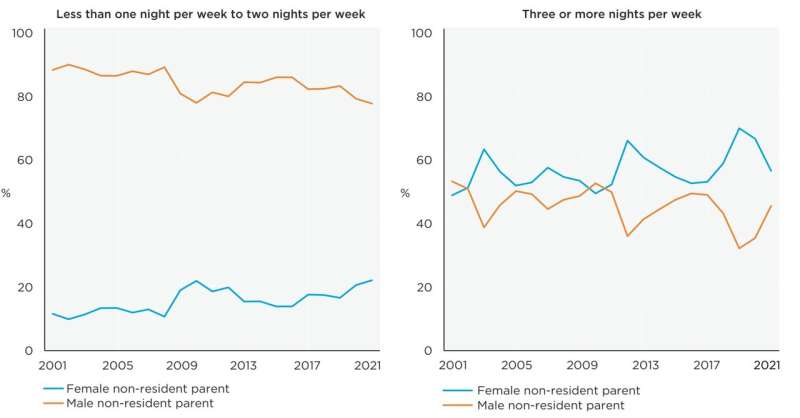This article has been reviewed according to Science X's editorial process and policies. Editors have highlighted the following attributes while ensuring the content's credibility:
fact-checked
trusted source
proofread
HILDA data show psychological distress rising, loneliness highest among young Australians

Younger Australians are experiencing higher psychological distress and more loneliness compared to older age groups, according to the latest HILDA data.
While distress and loneliness were more common during the pandemic, researchers are concerned about the long-term trends.
The data also shows teenagers are also more likely to use vapes or e-cigarettes than the rest of the population.
The 18th edition of the annual Household, Income and Labour Dynamics in Australia (HILDA) report examines data gathered between 2001 and 2021 by tracking over 17,000 people in over 9,000 households.
It provides valuable data about Australia's economic well-being, family and social life, and physical and mental health. This edition also includes insights into vaping and e-cigarette use for the first time and the second year of the COVID-19 pandemic.
"The distinguishing feature of HILDA is the same households and individuals are interviewed every year, allowing us to see how their lives are changing over time," said lead author Professor Roger Wilkins. "The data can tell us about the antecedents and consequences of life outcomes, such as poverty, unemployment, marital breakdown, and poor health because we can see the paths that individuals' lives took prior to those outcomes and the paths they take subsequently."
Loneliness highest among young people
Between 2001 and 2009, the greatest proportion of lonely people was among those aged 65 and older. However, by 2021, this group contained the lowest proportion of lonely individuals of all age groups, with the 15–24 age group now the highest. All other age groups had a lower proportion of lonely people in 2021 than in 2001.
"There is a clear trend of younger people becoming lonelier and feeling more isolated as time goes on,"' said co-author Dr. Ferdi Botha. "If there aren't actions taken or policies implemented to intervene, we may see loneliness and psychological distress increasing in the younger generations, and this may lead to lower mental and physical well-being and other wider societal issues.
"Loneliness increased in the first two years of the COVID-19 pandemic, but for young people, there is a longer-term trend increase apparent. It may be that this is partly connected to growth in smartphones and social media use," he said.
Psychological distress rising
Psychological distress levels decline with age, with the youngest age groups (15-24) reporting the highest average distress scores in 2021. Almost half (42.3 percent) of people aged 15-24 were psychologically distressed in 2021, up from 18.4 percent in 2011.
Between 2007 and 2021, the percentage of women who were psychologically distressed was higher than men. For men, the prevalence of psychological distress increased by roughly 51 percent over this period, whereas among women the prevalence of distress increased by about 63 percent.
HILDA looks at vaping for the first time
The 2021 data shows 14.1 percent of individuals aged 15 and above had tried electronic cigarettes or vaping devices.
Men were slightly more likely to use these products than women. Individuals who smoked tobacco had a 19.3 percentage-point higher probability of vaping compared to people who didn't smoke.
"Age is a significant factor in e-cigarette and vaping device usage with individuals between the ages of 15 and 19 predicted to have a 13.8 percentage-point higher probability of using these products than those aged 30 to 39," said Professor Wilkins. "This means teenagers are far more likely to vape or use e-cigarettes than their parents or teachers."
Marriage on the decline but partnered couples do better financially
There has been a decline in the proportion of married people, which is mirrored by growth in de facto relationships between 2001 and 2021. For men, the proportion of those married declined from 56.3 percent in 2001 to 50.3 percent, while the proportion in a de facto relationship rose from 9 percent to 14.7 percent.
For women, the proportion of those married declined from 54.5 percent to 48.2 percent, while those in a de facto relationship rose from 8.9 percent to 14.3 percent.
Going from partnered to single had considerably more adverse effects for women than men, reducing household income by at least 16.7 percent on average. The change from a partnered mother household to a single mother household was associated with an approximate 20 percent decline in equivalized household income, while the reverse was associated with a 22.4 percent to 28.5 percent increase.
"Compared to 2001, household incomes are higher, in part because the average tax rate is slightly lower,"' says Professor Wilkins. "Women are taxed at a lower rate than men on average, but that is due to lower levels of income earned. Inequality has declined slightly with the arrival of COVID. It was at its lowest during 2020 and increased slightly in 2021 but was still lower than before the pandemic."
Females more likely to work when unwell
In the four weeks preceding the survey, 16.8 percent of employed men and 19.8 percent of employed women reported working when physically unwell, while 11.1 percent of employed men and 19.1 percent of employed women reported working when mentally unwell. In total, 22.5 percent of employed men and 29.6 percent of employed women reported working when physically and/or mentally unwell.
People with a moderate or severe disability, or in poor mental health, were much more likely to work when unwell.
More information: HILDA report




















